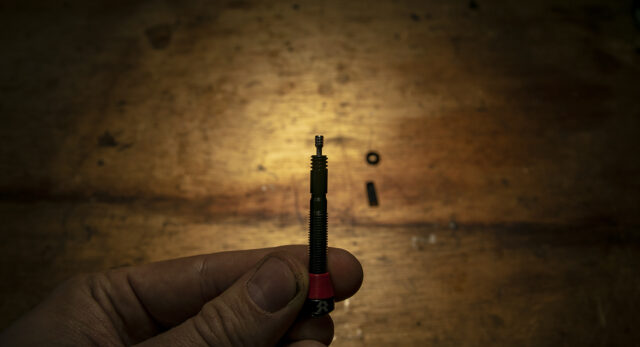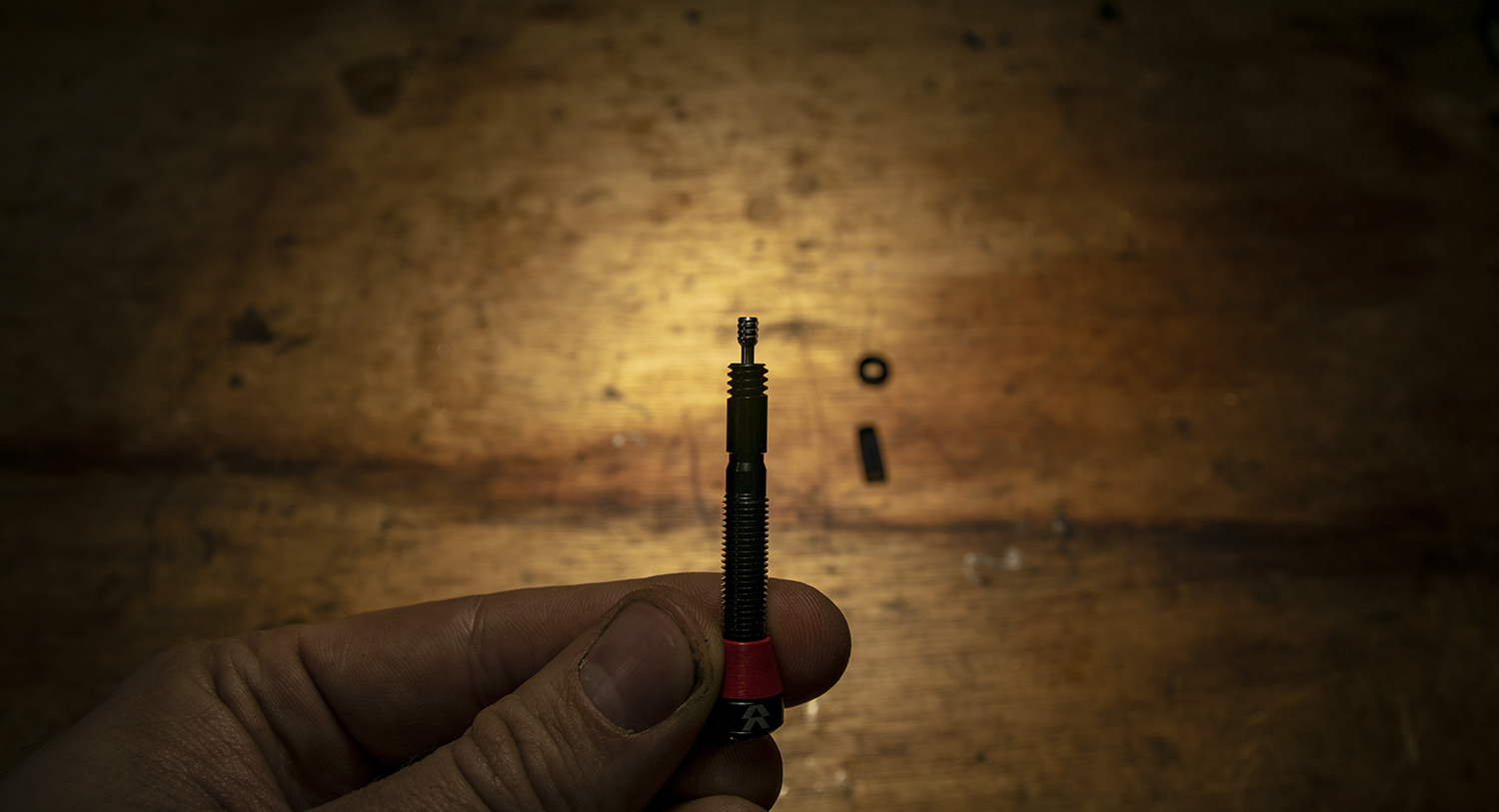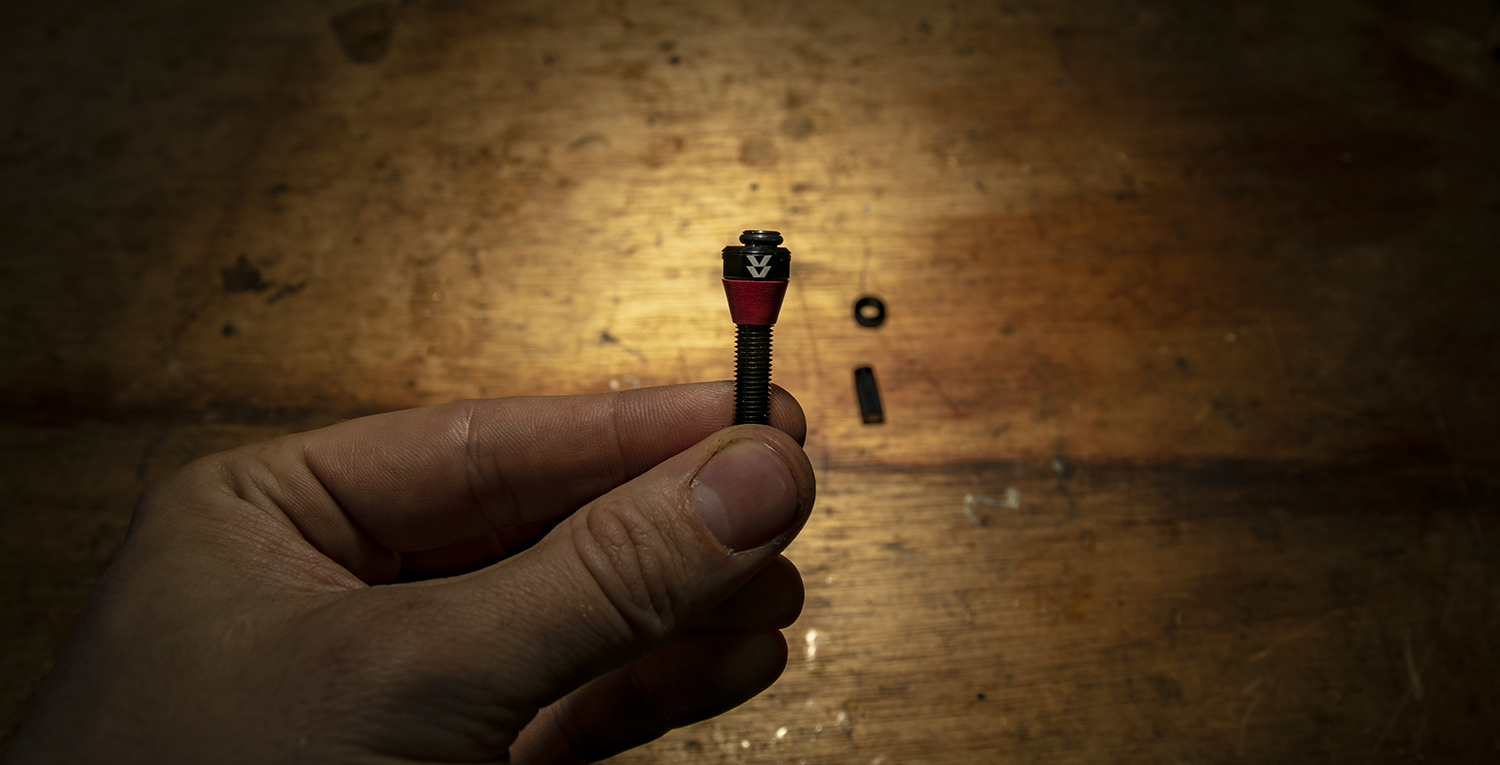Reserve Fillmore Tubeless Valves
Reviewer: 6’, 165 lbs / 183 cm, 74.8 kg
Test Locations: Washington
Test Duration: 3 months
Blister’s Measured Weight: 5.5 grams per valve
MSRP: $50 per pair
Mounted to: We Are One Union

Intro
If you had told me a few months ago that I’d soon be enthusiastically writing a review of tubeless valves, I probably wouldn’t have believed you. But today, Reserve Wheels is launching a fundamentally redesigned Presta valve, and after using them for a few months, they’re clearly better than the standard versions we’re all used to.
Design
The Fillmore valves fit in standard Presta valve holes and are compatible with typical Presta pumps as well. The magic happens internally.
Instead of using a typical valve core, the Fillmore uses a custom design, with only a thin stainless steel rod running through the middle of the core. An o-ring at the very top of the valve (the end that’s inside of the rim) handles sealing duties. This has two key advantages:
(1) The Fillmore valves flow way more air than typical Presta valves. My shop is equipped with an air compressor, but I still usually need to take the valve core out when seating a tubeless tire with a typical Presta valve. The standard design just can’t flow enough air quickly enough to get the job done in many instances. The Fillmore valves make it possible to seat tires with a floor pump, without messing around with the valve core. Just remove the valve cap and go.


In Use
The Fillmore valves really do deliver on their promise of better airflow. Having gotten used to them over the last couple of months, standard valves feel notably slow to work with. The added flow is especially helpful when trying to seat tires in the first place, but it does make adding and releasing air from the tire significantly faster, too. And while three months maybe isn’t quite enough test duration to definitively declare the Fillmore clog-proof, they’ve had no issues so far, and the design certainly does seem like it should be an improvement on that front. And if they do manage to clog, the Fillmore valves can be disassembled for cleaning, though doing so does require removing them from the wheel. I’ll report back if anything comes up, and I’ll definitely keep using the Fillmore valves going forward — they’re a genuine improvement over anything else I’ve tried to date.

I can also confirm that the Fillmore valves work reasonably well with Cush Core inserts. The contact with the insert does mean that it takes a little extra force to open the valve, and airflow is hampered slightly. But the Fillmore valves still work better with Cush Core than most standard valves (i.e., not the side-drilled Cush Core branded ones) by a big margin.
Bottom Line
The folks at Reserve have given the old Presta valve a re-think, and they’ve come up with something genuinely nicer to use — while still also being compatible with standard rims and pumps. I’ve been using a couple of pairs for several months now, and I’m completely sold. They flow air so much better than normal valves, making it faster and easier to seat tires, but also just to add or remove air on a day-to-day basis, too.

Valves may not be sexy, but I hate nothing more than the e*thirteen tubless valves that came with a used wheelset.
They were prone to coming unsealed. They didn’t work well with my floor pump or my hand pump because they didn’t have the normal threads (had to hold everything just right with one hand and pump with the other). Didn’t work with normal presta-schrader adapters for seating tires using a gas station air compressor. And they cost double what normal Stans or WTB valves cost at the LBS. Was so happy to get rid of them.
Unlike that garbage, these actually look like an intelligent attempt to rethink the valve.
sounds great, but $50 a set X my 3 mtb’s X my wife’s 2 mtbs, oh and 2 cross bikes = $400 for valve stems?
Bingo. This is 2x what I’ve paid for even the blingiest anodized aluminum stems on custom builds, and 3-4x the cost of industry standard Stan’s brass valves (assuming they didn’t come free w/ your wheels). Valves aren’t even a Top-5 factor in mounting a tubeless, and if you’ve worked your way that far down the troubleshooting ladder, it takes 2 seconds to pull a core. Sorry Santa Cruz, I don’t see the value. How will your internals clog less upon injection when I can’t pull your cores? That’s a huge minus in my book.
The one question I have is: if it DOES clog, is there any way to fix it?
With standard Presta valves, I pull the valve core out, and poke something like small Allen wrench through there. If the core is gummed up, I can easily replace it (light enough to carry a spare) or pick much of the gunk out of the gummed up one.
Is anything similar possible with these? Maybe disassembling it somehow?
Good point. They’re easy to disassemble if need be, though you do need to take them out of the wheel to do so. I added a line to the review covering that.
Why are there so few rims that support Schrader valve? You’d think that with modern, wide rims there would be more than enough room to fit them.
Unlike these and presta, there’s no possibly of bending them, valve core isn’t as fiddly as Presta, you don’t have to have special adapter and they provide much more airflow.
Because no one has used a Schrader valve on a bicycle worth more than $300 in over 30yrs. Bending has never been a factor for Presta, and every pump made in the last decade has an auto-head that simply adapts to whatever valve you put it on. Also in 35yrs of wrenching, I’ve never once failed to mount a tire due to airflow limitations at the valve. Poorly-designed rim profiles (replace them), problematic tires (soap them), bad taping (practice more), and weak compressors (add CFM) account for 99% of tubeless mounting problems. As for “fiddly” Presta cores, I can get them out in 2 seconds w/ my bare hands. Can you get your hands on your Schrader tool that fast?
Am I reading this right- the valve cap is integral to keeping air in the tire? I may not be the only rider who’s misplaced a cap out on the trail while adding or subtracting air pressure. Hm. So if lose the cap, I’m S.O.L….?
If you lose the cap, the fillmore stay closed buy the pressure.
I tried to ride with no cap, and no problem. In emmergency, you can put a presta plastic cap on your fillmore for dust protection.
But lose the fillmore aluminium cap is more difficult than with presta.
it is threaded inside and integral with the piston of the valve.
There is still the distraction, but with this price the distraction could be cured :-)
They are expensive but Lifetime Warranty
So if the cap regulates the air flow (the more you loosen the cap, the more air flows out), does that mean if you pull the cap to add a few lbs of air to an already inflated tire, will the tire go completely flat unless you get the pump on it real quick? Or am I misunderstanding something? That sounds stressful on the trail.
No, you need to both loosen the cap and then press down on it to let air out. How far you unthread the cap controls how quickly air comes out once you press the cap down, but it doesn’t lose air if you just take the cap off.
I see. That makes sense. I figured I was missing something. Sounds like a great design. Thanks for the reply David.
I see. That makes sense. I figured I was missing something. Sounds like a great design. Thanks for the reply David.
Are they available in different lengths? Web search only yielded one size… 50mm. I’ve got some really deep rims (Derby DH) and need long stems.
I got these and not sure if the extra air flow is really worth being at the mercy of the valve cap. I lose so many valve caps on my bikes it’s ridiculous. It’s a silly design choice to be required to need the valve cap in order for it to function. What happnens if you lose that tiny cap on the trail in the middle of nowhere?
These things are genuinely a game changer for me.
I tried ALL the valves designed to be used with inserts and they ALL clogged, like IMMEDIATELY, with Rimpact’s inserted.
Switched to Fillmore’s and they just never clog. They’re amazing!
I love these things. However, I’ve not been able to find a portable or frame-mounted bike pump that works with them. @David Golay, or anyone using Fillmores, what such pump have you found that works? (Love the Blister podcast btw.)
Been using Fillmore values for 3 years. I used to love them. However, they clog such that one is unable to add sealant through the valve which is a hassle (need to unbead the tire) for adding sealant after a puncture in which sealant is lost. At this point, it’s much easier to just have spare cores around. No more Fillmore values for me.